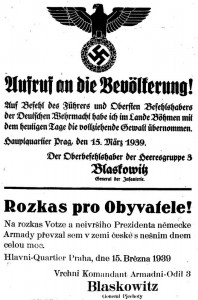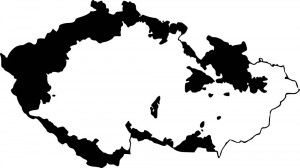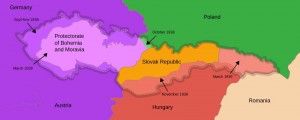The German occupation of Czechoslovakia proceeded in stages, starting in 1938. It began with the annexation of the largely German-populated Sudetenland and ended with the country’s complete conquest by the Nazis the following year. Czechoslovakia was then treated as a collection of Nazi protectorates by the Germans. It remained under occupation until Germany surrendered to the Allies in the spring of 1945.
Background
In the 1930s, the Sudeten German Party had been advocating for the rights of the ethnic Germans in the Sudetenland and the party’s leader, Konrad Henlein, was openly pro-Nazi. In March of 1938, Adolf Hitler used Henlein as the means to provoke a crisis with Czechoslovakia, having him make excessive demands to the government in Prague. The following month, the party published a program insisting on Sudeten autonomy and the freedom to align with Nazism.
The main military powers of Western Europe, France, and the United Kingdom were determined to avoid another European war. British Prime Minister Neville Chamberlain sympathized with the complaints of the Sudeten Germans, and believed that Hitler would not go further with his own territorial demands. Both countries therefore urged Czechoslovakia to concede. The Czechs refused, and by May the country’s troops were being partially mobilized. Hitler responded by secretly ordering war by October at the latest.
Occupation of the Sudetenland
 After a number of unsuccessful attempts to resolve the situation, a four-power conference took place in Munich in late September. Attending members included Britain, France, Germany, and Italy, but not Czechoslovakia itself. The following day, the Munich Agreement was signed and reluctantly accepted by the Czechs as the only way to avoid a war. The agreement allowed the Sudetenland to be occupied by Germany, with the final borders to be decided in a plebiscite at a later date.
After a number of unsuccessful attempts to resolve the situation, a four-power conference took place in Munich in late September. Attending members included Britain, France, Germany, and Italy, but not Czechoslovakia itself. The following day, the Munich Agreement was signed and reluctantly accepted by the Czechs as the only way to avoid a war. The agreement allowed the Sudetenland to be occupied by Germany, with the final borders to be decided in a plebiscite at a later date.
The Munich Agreement also resulted in the first Vienna Award. Under its provisions, Czechoslovakia was compelled to concede a third of Slovakia to the Hungarians, while Poland—with whom the Czechs had similarly failed to reach agreement—invaded the Zaolzie region, which had a strong Polish minority. By the beginning of March of 1939, 150,000 people in these regions had fled to what remained of Czechoslovakia itself.
Elections were held in the Sudetenland in December of 1938, resulting in a 97% vote for the Nazis. The party enjoyed a higher level of membership here than anywhere else in the Third Reich, with over 17% of the population signing up. Large numbers of Sudeten Germans found work in the Nazi Protectorate of Bohemia and Moravia, as well as in organizations such as the Gestapo, through being bilingual in German and Czech.
The Second Republic
The whole of Czechoslovakia was now very weak, and had no choice but to give concessions to other minorities. As a result, autonomous governments were established in Slovakia and Subcarpathian Ruthenia, which was populated largely by Russians and Ukrainians. In January of 1939, Britain and France attempted to offer support to Czechoslovakia by granting it £12 million, two-thirds in the form of a loan and the remainder as a gift. The new republic, which had now been officially renamed Czecho-Slovakia, consisted of three parts: Carpatho-Ukraine, Slovakia, and Bohemia-Moravia.
Having lost its original borders and fortifications, the new state was effectively indefensible and thus highly vulnerable to attack. When German talks with Poland collapsed in January 1939, Hitler decided to invade with the Poland, a feat which required the dissolution of Czechoslovakia. He decided to invade on March 15, and secretly met Slovak leaders in the days beforehand to prepare. Hitler told President Hácha of the invasion only when it was due to begin within a matter of hours, forcing him to surrender to avoid an air strike on Prague by the Luftwaffe.
The Allied Response
Chamberlain, who had staked so much on the success of the Munich Agreement, had now seen his work destroyed. At first he tried to claim that, as pro-Nazi Slovakia had declared independence the day before the German invasion, the country protected by the agreement no longer existed and the British were not required to defend it. This position was rejected in the United Kingdom, and by March 17, Chamberlain had changed his position. In Birmingham, he gave a speech acknowledging his lack of action and promising a stronger British response to Hitler.
The following day, both Britain and France told Germany that they considered the occupation of Czechoslovakia to be entirely against the Munich Agreement’s terms, and so would not recognize it. Hitler was not worried by the response, for both countries had protested before. However, although Czechoslovakia had been taken without a western military response, this would not be the case in September when Poland was invaded by the Nazis.
Resistance in Czechoslovakia
Although the country no longer existed in the eyes of the Nazis who saw it as merely a collection of protectorates of the Greater German Reich, Czechoslovakia remained significant throughout the war. It contained a substantial armaments industry, which churned out large numbers of guns and tanks for the Germans. There were also important chemical and steel factories, although the Germans moved a number of these to the Austrian region of Linz in order to give them greater security.
Resistance to German occupation persisted, with several main groups making up the resistance movement. These factions sometimes acted in concert and sometimes separately. A large number of Czechs fought in the ranks of the major Allied powers, with many even fighting alongside the British as far away as North Africa. Josef František became a successful fighter pilot with the Royal Air Force, with a considerable number of kills attributed to his name. Within Czechoslovakia, resistance groups included social democrats, communists, and intellectuals.
End of the Occupation

Czech territories with over
50% German population before 1945.
Photo by: Szczepan1990 Creative Commons
In September 1944, the first Czech villages were liberated by the Soviet Red Army. While a small part of southwestern Bohemia was liberated by the western Allies, the majority of Czechoslovakia’s territories were freed by the Soviets. The Russians set up a provisional government in early April of 1945. On May 5, the Prague Uprising saw the capital city’s citizens rise up against their Nazi occupiers. This revolt continued until the end of the war in Europe a few days later.
Around 350,000 Czechoslovaks died during WWII, the great majority of whom were Jews persecuted by the occupying Nazis. Thousands of Germans died after the war, when the new government expelled more than two million Germans from Czechoslovakia in revenge for the Nazis’ actions. After this, the country was nominally independent, but quickly fell under the sway of the Soviet Union. Communist control of Czechoslovakia persisted until the peaceful revolution of 1989 that overthrew the regime.
